Search results for: 'used woo'
- Related search terms
- wool comb
- Wool cardin
- used S
- used foam cutting machine'
- Used+Ga
-
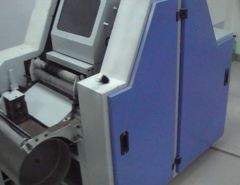 G-3939 SAMPLE COTTON CARDREFERENCE NUMBER: G-3939 SAMPLE COTTON CARD MODEL: FDY-360G APPLICATIONS: THIS MACHINE IS MAINLY USED IN LOOSING AND CARDING COTTON, WOOL, AND CHEMICAL FABRICS IN VARIOUS COLORS, AND WINDING THEM ON THE ROLLER. ALL OF THESE ARE SPECIALLY USED BY WOOL, PLUSH, AND PRINTING AND DYEING MILLS. QUANTITY AVAILABLE: 1 Learn More
G-3939 SAMPLE COTTON CARDREFERENCE NUMBER: G-3939 SAMPLE COTTON CARD MODEL: FDY-360G APPLICATIONS: THIS MACHINE IS MAINLY USED IN LOOSING AND CARDING COTTON, WOOL, AND CHEMICAL FABRICS IN VARIOUS COLORS, AND WINDING THEM ON THE ROLLER. ALL OF THESE ARE SPECIALLY USED BY WOOL, PLUSH, AND PRINTING AND DYEING MILLS. QUANTITY AVAILABLE: 1 Learn More -
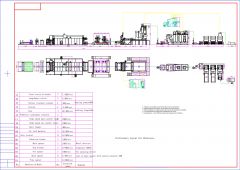 YY-2251 AIRLAID PRODUCTION LINE, FINAL PRODUCT WIDTH 2200mmYY-2251 AIRLAID PRODUCTION LINE, FINAL PRODUCT WIDTH 2200mm ITEM 001 BALE OPENER (2 SETS) AND SEALED BALE OPENER (1 SET) ITEM 002 FIBER OPENING MACHINE (FOR LOW MELT FIBER OR PP) - 1 SET ITEM 003 PRE-OPENER – 1 SET ITEM 004 BIG CHAMBER BLENDER – 1 SET ITEM 005 MAIN-OPENER – 1 SET ITEM 006 VIBRATING FEEDER – 1 SET ITEM 007 CONDENSER – 2 SETS ITEM 008 AUTO-LEVER - 1 SET ITEM 009 AIR LAID MACHINE – 1 SET ITEM 010 AUTO-LEVER – 1 SET ITEM 011 BATT FEEDER – 1 SET ITEM 012 HIGH SPEED SINGLE SHAFT SINGLE BOARD PRE NEEDLE LOOM – 1 SET ITEM 013 HIGH SPEED SINGLE SHAFT SINGLE BOARD MAIN NEEDLE LOOM – 1 SET ITEM 014 DOUBLE BELT THERMAL-BONDED OVEN – 1 SET ITEM 015 DOUBLE-ROLLER CALENDER MACHINE – 1 SET ITEM 016 COOLING UNIT – 1 SET Learn More
YY-2251 AIRLAID PRODUCTION LINE, FINAL PRODUCT WIDTH 2200mmYY-2251 AIRLAID PRODUCTION LINE, FINAL PRODUCT WIDTH 2200mm ITEM 001 BALE OPENER (2 SETS) AND SEALED BALE OPENER (1 SET) ITEM 002 FIBER OPENING MACHINE (FOR LOW MELT FIBER OR PP) - 1 SET ITEM 003 PRE-OPENER – 1 SET ITEM 004 BIG CHAMBER BLENDER – 1 SET ITEM 005 MAIN-OPENER – 1 SET ITEM 006 VIBRATING FEEDER – 1 SET ITEM 007 CONDENSER – 2 SETS ITEM 008 AUTO-LEVER - 1 SET ITEM 009 AIR LAID MACHINE – 1 SET ITEM 010 AUTO-LEVER – 1 SET ITEM 011 BATT FEEDER – 1 SET ITEM 012 HIGH SPEED SINGLE SHAFT SINGLE BOARD PRE NEEDLE LOOM – 1 SET ITEM 013 HIGH SPEED SINGLE SHAFT SINGLE BOARD MAIN NEEDLE LOOM – 1 SET ITEM 014 DOUBLE BELT THERMAL-BONDED OVEN – 1 SET ITEM 015 DOUBLE-ROLLER CALENDER MACHINE – 1 SET ITEM 016 COOLING UNIT – 1 SET Learn More -
 K-3713 LAUNDRY SOAP PRODUCTION LINE-CAPACITY 1000 -1500 KG/HR
K-3713 LAUNDRY SOAP PRODUCTION LINE-CAPACITY 1000 -1500 KG/HRREFERENCE NUMBER: K-3713 LAUNDRY SOAP PRODUCTION LINE-CAPACITY 1000 -1500 KG/HR THIS PRODUCT LINE IS A SOAP COMPLETE LINE STARTING FROM OIL MELTING, SAPONIFYING, VACUUM DRYING AND COOLING, MILLING SOAP NOODLES AND REFINING CONTINUOUSLY, THEN STAMPING INTO SOAPS. THIS PRODUCT LINE HAS ADVANCED TECHNOLOGY INCLUDING COVERING LESS FLOOR AREA, CONSUMING LESS ENERGY, SAVING HUMAN RESOURCES, AUTOMATING PROCESSES, PRODUCING HIGH QUALITY SOAPS WITH 50 TO 80% FATTY ACID CONTENT. QUANTITY AVAILABLE: 1
Learn More -
 TT-4300 SPANNER RE² GMBH, JENBACHER HKA 70 UND BHKW TYP JMS 320 GS-SL WOOD GASIFIER, CHP, YEAR 2022TT-4300 SPANNER RE² GMBH, JENBACHER HKA 70 UND BHKW TYP JMS 320 GS-SL WOOD GASIFIER, CHP, YEAR 2022 SPANNER RE² GMBH, JENBACHER HKA 70 UND BHKW TYP JMS 320 GS-SL WOOD GASIFIER, CHP YEAR OF CONSTRUCTION 2022 QUANTITY: 1 Learn More
TT-4300 SPANNER RE² GMBH, JENBACHER HKA 70 UND BHKW TYP JMS 320 GS-SL WOOD GASIFIER, CHP, YEAR 2022TT-4300 SPANNER RE² GMBH, JENBACHER HKA 70 UND BHKW TYP JMS 320 GS-SL WOOD GASIFIER, CHP, YEAR 2022 SPANNER RE² GMBH, JENBACHER HKA 70 UND BHKW TYP JMS 320 GS-SL WOOD GASIFIER, CHP YEAR OF CONSTRUCTION 2022 QUANTITY: 1 Learn More -
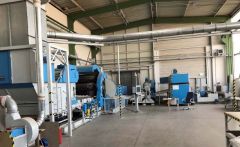 NEEDLE PUNCH LINE, EXIT WIDTH 2200/2500mm, CAPACITY 400 KGS, OVERHAULED AND UPDATED 2012 AND 2015REFERENCE NUMBER: T-6868 NEEDLE PUNCH LINE, EXIT WIDTH 2200/2500mm, CAPACITY 400 KGS, OVERHAULED AND UPDATED 2012 AND 2015 NEEDLE PUNCH LINE EXIT WIDTH 2200/2500mm OVERHAULED AND UPDATED IN 2012/2015 TECHNOLOGY CONTROL BY S7 DESIGNED AND USED FOR NATURAL FIBRES, GLASS FIBRES, RECYCLED FIBRES 100% OR MIXED WITH PP FOR BASIC MATERIALS OF THE AUTOMOTIVE INDUSTRY CAPACITY: 400 KGS ITEM 001 2 BALE OPENER BRAND TEMAFA WORKING WIDTH: 1400mm WOODEN LATICE BELTS WOODEN TRANSPORT LATTICE VERY GOOD CONDITION INDIVIDUAL CONTROL OF OPENING AND MIXING ITEM 002 WILLOW BRAND TEMAFA 4 PAIRS STRIPPING AND WORKING ROLLERS WORKING WIDTH: 1400mm WITH VENTILATOR AND PIPE SYSTEM TO CHUTE FEED AND HOPPER FEEDER ITEM 003 CHUTE FEED BRAND TEMAFA WORKING WIDTH: 2700mm CONTROL OF FILLING HEIGHT BY ULTRASOUND SENSORS ITEM 004 HOPPER FEEDER BRAND OCTIR (RSP) GROUND BELT BY WOODEN LATTICE AND DRIVEN BY SEPARATE DRIVE VIA ECCENTRIC VIBRATION WALL MOBILE FRON WALL ITEM 005 CARDING MACHINE WORKING WIDTH: 2500mm 5 PAIRD STRIPPER AND WORKER INSTALLED 1 PAIR STRIPPER/WORKER SEPARATE DELIVERY INDIVIDUAL DRIVE SYSTEMS RIGID CARD CLOTHING MAIN DRUM 1600mm DIAMETER DOFFER DRUM 1200mm AND FLY COMB ITEM 006 CROSS LAPPER WEB FEEDING BY TRANSILON-BELTS EXIT BELT AS WOODEN LATTICE BELT ITEM 007 PRE-NEEDLE MACHINE BRAND DILO MODI DVM25 WORKING WIDTH: 2500mm ALL BELT SYSTEMS USE WOODEN LATTICE BELTS 1 NEEDLE BOARD NEEDLING FROM TOP TO BOTTOM ITEM 008 NEEDLE MACHINE BRAND ASSELIN WORKING WIDTH: 2200mm 4 NEEDLE BAR MACHINE (2 TOP/2 BOTTOM) ALTERNATING AND SIMULTANEOUS WORKING METHODS BY MODIFICATION OF DRIVING BELT WAYS PULL-OUT ROLLERS AT EXIT STROKE HEIGHT 40mm ITEM 009 ROLLING MACHINE 3 LONGITUDINAL CUTTER (TOP AND BOTTOM DRIVEN) 1 CROSS CUTTER CONTROL OF THE LINE: SEPARATE SYSTEM FOR BALE OPENING AND MIXING S7 CONTROL FOR COMPLETE LINE UPR TO DATE LEVEL, AIRCONDITIONED, CONTROL CABINETS CLOSE TO MACHINE OR SEPARATE MACHINES ARE IN VERY GOOD AND UPDATED CONDITION Learn More
NEEDLE PUNCH LINE, EXIT WIDTH 2200/2500mm, CAPACITY 400 KGS, OVERHAULED AND UPDATED 2012 AND 2015REFERENCE NUMBER: T-6868 NEEDLE PUNCH LINE, EXIT WIDTH 2200/2500mm, CAPACITY 400 KGS, OVERHAULED AND UPDATED 2012 AND 2015 NEEDLE PUNCH LINE EXIT WIDTH 2200/2500mm OVERHAULED AND UPDATED IN 2012/2015 TECHNOLOGY CONTROL BY S7 DESIGNED AND USED FOR NATURAL FIBRES, GLASS FIBRES, RECYCLED FIBRES 100% OR MIXED WITH PP FOR BASIC MATERIALS OF THE AUTOMOTIVE INDUSTRY CAPACITY: 400 KGS ITEM 001 2 BALE OPENER BRAND TEMAFA WORKING WIDTH: 1400mm WOODEN LATICE BELTS WOODEN TRANSPORT LATTICE VERY GOOD CONDITION INDIVIDUAL CONTROL OF OPENING AND MIXING ITEM 002 WILLOW BRAND TEMAFA 4 PAIRS STRIPPING AND WORKING ROLLERS WORKING WIDTH: 1400mm WITH VENTILATOR AND PIPE SYSTEM TO CHUTE FEED AND HOPPER FEEDER ITEM 003 CHUTE FEED BRAND TEMAFA WORKING WIDTH: 2700mm CONTROL OF FILLING HEIGHT BY ULTRASOUND SENSORS ITEM 004 HOPPER FEEDER BRAND OCTIR (RSP) GROUND BELT BY WOODEN LATTICE AND DRIVEN BY SEPARATE DRIVE VIA ECCENTRIC VIBRATION WALL MOBILE FRON WALL ITEM 005 CARDING MACHINE WORKING WIDTH: 2500mm 5 PAIRD STRIPPER AND WORKER INSTALLED 1 PAIR STRIPPER/WORKER SEPARATE DELIVERY INDIVIDUAL DRIVE SYSTEMS RIGID CARD CLOTHING MAIN DRUM 1600mm DIAMETER DOFFER DRUM 1200mm AND FLY COMB ITEM 006 CROSS LAPPER WEB FEEDING BY TRANSILON-BELTS EXIT BELT AS WOODEN LATTICE BELT ITEM 007 PRE-NEEDLE MACHINE BRAND DILO MODI DVM25 WORKING WIDTH: 2500mm ALL BELT SYSTEMS USE WOODEN LATTICE BELTS 1 NEEDLE BOARD NEEDLING FROM TOP TO BOTTOM ITEM 008 NEEDLE MACHINE BRAND ASSELIN WORKING WIDTH: 2200mm 4 NEEDLE BAR MACHINE (2 TOP/2 BOTTOM) ALTERNATING AND SIMULTANEOUS WORKING METHODS BY MODIFICATION OF DRIVING BELT WAYS PULL-OUT ROLLERS AT EXIT STROKE HEIGHT 40mm ITEM 009 ROLLING MACHINE 3 LONGITUDINAL CUTTER (TOP AND BOTTOM DRIVEN) 1 CROSS CUTTER CONTROL OF THE LINE: SEPARATE SYSTEM FOR BALE OPENING AND MIXING S7 CONTROL FOR COMPLETE LINE UPR TO DATE LEVEL, AIRCONDITIONED, CONTROL CABINETS CLOSE TO MACHINE OR SEPARATE MACHINES ARE IN VERY GOOD AND UPDATED CONDITION Learn More -
 TT-5772 RE2 HKA 70 SPANNER WOODEN CARBURETOR, 70KW, YEAR 2017TT-5772 RE2 HKA 70 SPANNER WOODEN CARBURETOR, 70KW, YEAR 2017 RE2 HKA 70 SPANNER WOODEN CARBURETOR, 70KW CONDITION: USED MACHINE DESCRIPTION: WOODEN CARBURETOR QUANTITY: 1 Learn More
TT-5772 RE2 HKA 70 SPANNER WOODEN CARBURETOR, 70KW, YEAR 2017TT-5772 RE2 HKA 70 SPANNER WOODEN CARBURETOR, 70KW, YEAR 2017 RE2 HKA 70 SPANNER WOODEN CARBURETOR, 70KW CONDITION: USED MACHINE DESCRIPTION: WOODEN CARBURETOR QUANTITY: 1 Learn More -
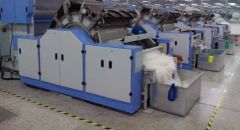 YY-2044 USED CASHMERE CARDING MACHINE/FIBER CARDING MACHINE WITH HIGH QUALITY, PRODUCTION CAPACITY 10 TO 13 KG PER HOURYY-2044 USED CASHMERE CARDING MACHINE/FIBER CARDING MACHINE WITH HIGH QUALITY, PRODUCTION CAPACITY 10 TO 13 KG PER HOUR DETAILS: CONDITION: USED APPLICABLE INDUSTRIES: MANUFACTURING PLANT, FARMS CORE COMPONENTS: BEARING APPLICATION: CASHMERE AUTOMATIC GRADE: AUTOMATIC PRODUCTION CAPACITY: 10 TO 13 KG/HOUR VOLTAGE: 220 VOLTS OR PER CUSTOMER REQUIREMENT POWER: 2.8 KW DIMENSION (L X W X H): 3000 X 2400 X 1800(mm) WEIGHT: 5800 KG NAME: CASHMERE CARDING MACHINE COLOR: WHITE AND BLUE QUANTITY: 1 Learn More
YY-2044 USED CASHMERE CARDING MACHINE/FIBER CARDING MACHINE WITH HIGH QUALITY, PRODUCTION CAPACITY 10 TO 13 KG PER HOURYY-2044 USED CASHMERE CARDING MACHINE/FIBER CARDING MACHINE WITH HIGH QUALITY, PRODUCTION CAPACITY 10 TO 13 KG PER HOUR DETAILS: CONDITION: USED APPLICABLE INDUSTRIES: MANUFACTURING PLANT, FARMS CORE COMPONENTS: BEARING APPLICATION: CASHMERE AUTOMATIC GRADE: AUTOMATIC PRODUCTION CAPACITY: 10 TO 13 KG/HOUR VOLTAGE: 220 VOLTS OR PER CUSTOMER REQUIREMENT POWER: 2.8 KW DIMENSION (L X W X H): 3000 X 2400 X 1800(mm) WEIGHT: 5800 KG NAME: CASHMERE CARDING MACHINE COLOR: WHITE AND BLUE QUANTITY: 1 Learn More -
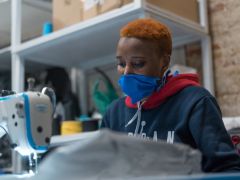 D-2388 What’s the Best Material for a Mask?
D-2388 What’s the Best Material for a Mask?Federal health officials have now recommended that we cover our faces with fabric during the coronavirus pandemic. But what material offers the most protection?
The Centers for Disease Control and Prevention has posted a no-sew mask pattern using a bandanna and a coffee filter as well as a video on making masks using rubber bands and folded fabrics found at home.
While a simple face covering can reduce the spread of coronavirus by blocking outgoing germs from coughs or sneezes of an infected person, experts say there is more variation in how much homemade masks might protect the wearer from incoming germs, depending on the fit and quality of the material used.
Scientists around the country have taken it upon themselves to identify everyday materials that do a better job of filtering microscopic particles. In recent tests, HEPA furnace filters scored well, as did vacuum cleaner bags, layers of 600-count pillowcases and fabric similar to flannel pajamas. Stacked coffee filters had medium scores. Scarves and bandanna material had the lowest scores, but still captured a small percentage of particles.
If you don’t have any of the materials that were tested, a simple light test can help you decide whether a fabric is a good candidate for a mask.
“Hold it up to a bright light,” said Dr. Scott Segal, chairman of anesthesiology at Wake Forest Baptist Health who recently studied homemade masks. “If light passes really easily through the fibers and you can almost see the fibers, it’s not a good fabric. If it’s a denser weave of thicker material and light doesn’t pass through it as much, that’s the material you want to use.”
Researchers say it’s important to remember that lab studies are conducted under perfect conditions with no leaks or gaps in the mask, but the test methods give us a way to compare materials. And while the degree of filtration for some homemade masks seems low, most of us — who are staying home and practicing social distancing in public — don’t need the high level of protection required for medical workers. More important, any face covering is better than none, especially if worn by a person who has the virus but doesn’t know it.
The biggest challenge of choosing a homemade mask material is to find a fabric that is dense enough to capture viral particles, but breathable enough that we can actually wear it. Some items being touted online promise high filtration scores, but the material would be unwearable.
Dressing Up for Work … at Home
Yang Wang, an assistant professor of environmental engineering at Missouri University of Science and Technology, worked with his graduate students to study various combinations of layered materials — including both air filters and fabric. “You need something that is efficient for removing particles, but you also need to breathe,” said Dr. Wang, who last fall won an international award for aerosol research.To test everyday materials, scientists are using methods similar to those used to test medical masks, which everybody agrees should be saved for medical workers who are exposed to high doses of virus from seeing infected patients. The best medical mask — called the N95 respirator — filters out at least 95 percent of particles as small as 0.3 microns. By comparison, a typical surgical mask — made using a rectangular piece of pleated fabric with elastic ear loops — has a filtration efficiency ranging from 60 to 80 percent.
Dr. Wang’s group tested two types of air filters. An allergy-reduction HVAC filter worked the best, capturing 89 percent of particles with one layer and 94 percent with two layers. A furnace filter captured 75 percent with two layers, but required six layers to achieve 95 percent. To find a filter similar to those tested, look for a minimum efficiency reporting value (MERV) rating of 12 or higher or a microparticle performance rating of 1900 or higher.
The problem with air filters is that they potentially could shed small fibers that would be risky to inhale. So if you want to use a filter, you need to sandwich the filter between two layers of cotton fabric. Dr. Wang said one of his grad students made his own mask by following the instructions in the C.D.C. video, but adding several layers of filter material inside a bandanna.
Dr. Wang’s group also found that when certain common fabrics were used, two layers offered far less protection than four layers. A 600 thread count pillow case captured just 22 percent of particles when doubled, but four layers captured nearly 60 percent. A thick woolen yarn scarf filtered 21 percent of particles in two layers, and 48.8 percent in four layers. A 100 percent cotton bandanna did the worst, capturing only 18.2 percent when doubled, and just 19.5 percent in four layers.
The group also tested Brew Rite and Natural Brew basket-style coffee filters, which, when stacked in three layers, showed 40 to 50 percent filtration efficiency — but they were less breathable than other options.
If you are lucky enough to know a quilter, ask them to make you a mask. Tests performed at the Wake Forest Institute for Regenerative Medicine in Winston-Salem, N.C., showed good results for homemade masks using quilting fabric. Dr. Segal, of Wake Forest Baptist Health, who led the study, noted that quilters tend to use high-quality, high-thread count cotton. The best homemade masks in his study were as good as surgical masks or slightly better, testing in the range of 70 to 79 percent filtration. Homemade masks that used flimsier fabric tested as low as 1 percent filtration, Dr. Segal said.
The best-performing designs were a mask constructed of two layers of high-quality, heavyweight “quilter’s cotton,” a two-layer mask made with thick batik fabric, and a double-layer mask with an inner layer of flannel and outer layer of cotton.
Bonnie Browning, executive show director for the American Quilter’s Society, said that quilters prefer tightly woven cottons and batik fabrics that stand up over time. Ms. Browning said most sewing machines can handle only two layers of fabric when making a pleated mask, but someone who wanted four layers of protection could wear two masks at a time.
Ms. Browning said she recently reached out to quilters on Facebook and heard from 71 people who have made a combined total of nearly 15,000 masks. “We quilters are very much in the thick of what’s going on with this,” said Ms. Browning, who lives in Paducah, Ky. “One thing most of us have is a stash of fabric.”
People who don’t sew could try a folded origami mask, created by Jiangmei Wu, assistant professor of interior design at Indiana University. Ms. Wu, who is known for her breathtaking folded artwork, said she began designing a folded mask out of a medical and building material called Tyvek, as well as vacuum bags, after her brother in Hong Kong, where mask wearing is common, suggested it. (DuPont, the maker of Tyvek, said in a statement that Tyvek is intended for medical apparel, not masks.) The folded mask pattern is free online, as is a video demonstrating the folding process. In tests at Missouri University and University of Virginia, scientists found that vacuum bags removed between 60 percent and 87 percent of particles. But some brands of vacuum bags may contain fiberglass or are harder to breathe through than other materials, and shouldn’t be used. Ms. Wu used a bag by EnviroCare Technologies, which has said it does not use fiberglass in its paper and synthetic cloth bags.
“I wanted to create an alternative for people who don’t sew,” said Ms. Wu, who said she is talking to various groups to find other materials that will be effective in a folded mask. “Given the shortage of all kinds of materials, even vacuum bags might run out.”
The scientists who conducted the tests used a standard of 0.3 microns because that is the measure used by the National Institute for Occupational Safety and Health for medical masks.
Linsey Marr, a Virginia Tech aerosol scientist and an expert in the transmission of viruses, said the certification method for respirators and HEPA filters focuses on 0.3 microns because particles around that size are the hardest to catch. While it seems counterintuitive, particles smaller than 0.1 microns are actually easier to catch because they have a lot of random motion that makes them bump into the filter fibers, she said.
“Even though coronavirus is around 0.1 microns, it floats around in a wide range of sizes, from around 0.2 to several hundred microns, because people shed the virus in respiratory fluid droplets that also contain lots of salts and proteins and other things,” said Dr. Marr. “Even if the water in the droplets fully evaporates, there’s still a lot of salt and proteins and other gunk that stays behind as solid or gel-like material. I think 0.3 microns is still useful for guidance because the minimum filtration efficiency will be somewhere around this size, and it’s what NIOSH uses.”
Learn More -
 T-8614 ALPACA/SHEEP WOOL CLEANER/PICKER, WORKING WIDTH 1200mm, 200 KG PER HOURT-8614 ALPACA/SHEEP WOOL CLEANER/PICKER, WORKING WIDTH 1200mm, 200 KG PER HOUR QUANTITY: 1 Learn More
T-8614 ALPACA/SHEEP WOOL CLEANER/PICKER, WORKING WIDTH 1200mm, 200 KG PER HOURT-8614 ALPACA/SHEEP WOOL CLEANER/PICKER, WORKING WIDTH 1200mm, 200 KG PER HOUR QUANTITY: 1 Learn More -
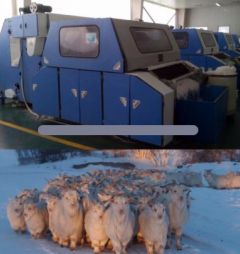 YY-2051 NEW CASHMERE AND SHEEP WOOL CARDING MACHINE, PRODUCTION EFFICIENCY 98%YY-2051 NEW CASHMERE AND SHEEP WOOL CARDING MACHINE, PRODUCTION EFFICIENCY 98% DETAILS: CONDITION: NEW APPLICABLE INDUSTRIES: MANUFACTURING PLANT, FARMS CORE COMPONENTS: BEARING APPLICATION: WOOL, CASHMERE AUTOMATIC GRADE: AUTOMATIC PRODUCTION EFFICIENCY: 98% VOLTAGE: 220 VOLTS, 3-PHASE OR AS PER CUSTOMER REQUIREMENT DIMENSIONS (L X W X H): 3000 X 2400 X 1800(mm) WEIGHT: 5800 KG QUANTITY: 1 Learn More
YY-2051 NEW CASHMERE AND SHEEP WOOL CARDING MACHINE, PRODUCTION EFFICIENCY 98%YY-2051 NEW CASHMERE AND SHEEP WOOL CARDING MACHINE, PRODUCTION EFFICIENCY 98% DETAILS: CONDITION: NEW APPLICABLE INDUSTRIES: MANUFACTURING PLANT, FARMS CORE COMPONENTS: BEARING APPLICATION: WOOL, CASHMERE AUTOMATIC GRADE: AUTOMATIC PRODUCTION EFFICIENCY: 98% VOLTAGE: 220 VOLTS, 3-PHASE OR AS PER CUSTOMER REQUIREMENT DIMENSIONS (L X W X H): 3000 X 2400 X 1800(mm) WEIGHT: 5800 KG QUANTITY: 1 Learn More
